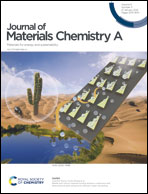Heterostructure enhanced sodium storage performance for SnS2 in hierarchical SnS2/Co3S4 nanosheet array composite†
Abstract
Herein, a uniformly distributed SnS2/Co3S4 heterostructure nanosheet array was grown on carbon cloth (CC) fibers by a simple solvothermal method and an oil bath method. When the hierarchical SnS2/Co3S4@CC nanoarray composite is used as a binder-free anode for sodium-ion batteries, its charge and discharge capacity is stabilized at 910.1 mA h g−1 at a current density of 0.5 A g−1 after 100 cycles. Even under a high current density of 2 A g−1, after 760 long-term cycles, the reversible capacity is stable at 637.2 mA h g−1, and still has excellent cycle stability with capacity retention of 87.3%. This excellent performance can be attributed to the reasonable design of the arrayed-electrode structure and the in situ growth of Co3S4 nanoparticles on the heterointerface of matrix SnS2 nanosheets: the well-defined array structure can shorten the diffusion path of Na+ ions and effectively alleviates volume expansion under long-cycle performance; the hierarchical heterostructure of SnS2/Co3S4 nanosheets can expand the interface contact area, provide more active sites and effectively enhance the electrochemical kinetics for sodium storage. The excellent electrochemical performance brought by the rational design of the heterogeneous nanostructure arrays provides new possibilities for the practical application of energy storage in the future.



 Please wait while we load your content...
Please wait while we load your content...